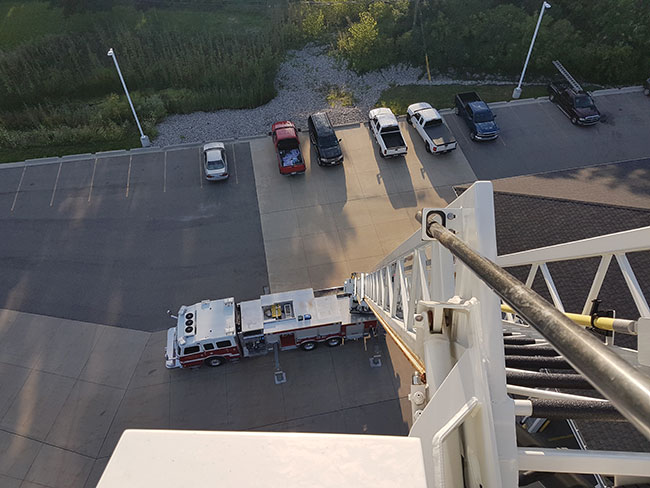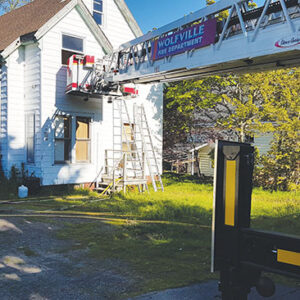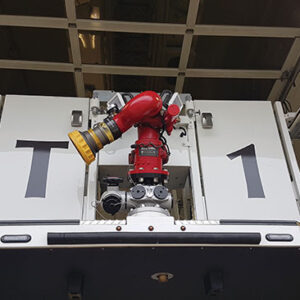
Features
Back to Basics: The tenets of VES, Part 3
November 7, 2022
By
Mark van
 Photo 1: Being elevated can be scary for many people you are rescuing. ALL PHOTOS: Mark van der Feyst
Photo 1: Being elevated can be scary for many people you are rescuing. ALL PHOTOS: Mark van der Feyst In Part 3 of this Vent, Enter, Search (VES) series, we are going to look at the tactic being performed using an aerial device as opposed to a ground ladder. Most times we equate doing VES with only a ground ladder at a residential structure, but the same tactic can be used at higher elevations using an aerial device.
When we think of residential structures, we usually picture a house, one or two stories high and sitting on a plot of land. But in suburban areas and metropolitan cities, residential structures are often more vertical than horizontal. Many municipalities are building up as opposed to building out because land in no longer available.
One restriction with doing VES at higher elevations is the reach of the aerial device in contrast to the building. The average aerial device is going to be 100 feet or 30 meters long, which will allow us to reach roughly the 10th floor or less. Anything higher than the 10th floor will require a different tactic be used, such as shelter in place.
Another restriction is the fact that the team will be working at a higher elevation and when they have removed a person from the room, it will take some time to bring them down to the ground for EMS attention. Depending upon the severity of their injuries or their state of consciousness, they may be able to walk/climb down the ladder with the assistance of another firefighter, or they will need to be brought down to the ground by the aerial device. As you will see in Photo 1, being elevated can be a scary endeavor for most people, let alone assisting them down an aerial ladder to the ground, which may force the aerial device to have to be lowered down.
The speed of the aerial device will also be a restriction. Getting an aerial ladder or platform up to a balcony or window will take some time compared to a ground ladder going to the second or third story window. Set up of the out-riggers must be done before the aerial device can be lifted out of the cradle. Once set up, each manufacturer will have varying speeds of the aerial device to work with, and if the pump on board is being used for water delivery, the aerial speed will be governed by the speed of the pump. If there are more than one window or rooms to be searched using VES, the time it takes to move the aerial device from one spot to the next will also be time consuming.
There will be differences in operational approach based on the type of aerial device being used by the department, which will either be a straight ladder stick or a platform ladder. We are going to detail both types of operational approach for this tactic. Photo 2 shows a platform aerial ladder. With this type of aerial device, performing VES will and can be accomplished using only two firefighters in the platform bucket. This will allow for one firefighter to enter the room and perform the tactic and leave one firefighter at the window in the bucket, just like using a ground ladder at a house. With both firefighters in the bucket, the aerial device can be raised into position without having to have the firefighters climb up the ladder to the bucket. This will save time and expenditure of energy. The one firefighter in the bucket can operate the aerial device from the bucket controls, eliminating the need for a third firefighter to operate.
Do not position the platform bucket floor at the tip of the window. As you will see in Photo 2, the platform bucket needs to be positioned so that the floor of the bucket is level with the floor of the building or room. Same goes for a balcony type of entry. The reason for this is to make the transition between the bucket and the room a lot easier for both the firefighter and the occupant. With the bucket floor being even with the room floor, the railing of the bucket will not be higher than the windowsill or balcony railing. When a firefighter or occupant is transitioning from one to the other, they can position the one leg over the railing/windowsill edge and into the platform bucket with the other leg still inside the room (they will be straddling the window and the bucket). If the platform bucket has side doors that can open, that should assist with making the transition easier.
Many platforms will have angled buckets as pictured in Photo 3. This will assist with making transitions from the bucket to the room easier. As described in the previous paragraph, the platform can be positioned at the window with the angled part facing the window or building wall. This will be dictated by the position of the aerial apparatus in relation to the building.
The platform can accommodate securing the rescued person inside while bringing them down, or two persons inside along with the one firefighter. This may require that one firefighter climb down the ladder a section so that the load in the platform bucket and on the ladder frame will not be exceeded. Using the load chart on the side of the aerial ladder will let the team know if they can accommodate this or not.
With the straight ladder stick type of aerial device, there are a few differences in operations. The tip of the ladder still needs to be positioned at the windowsill just like a ground ladder. The aerial ladder will be brought up either beside the window and then under the windowsill, or above the window and then down under the windowsill. This will eliminate the possibility of a person trying to jump onto the aerial ladder from the window (if there is a person at the window calling from help). With that one person removed, the firefighter can then enter to VES that room.
The straight ladder stick will require a firefighter to control/operate it from the pedestal which will take away a team member or be that third firefighter on the team. Two firefighters will be on the aerial ladder to perform the tactic with one going in and the other at the window waiting. Should there be only two firefighters available, it is possible to perform this with one at the pedestal and one going inside.
The handrails of the aerial ladder will be an obstacle in the removal of the occupant. The cross-arm method used on a ground ladder cannot be used on the aerial ladder – instead the occupant needs to be placed on the ladder rungs with the one firefighter securing them and be brought down to the ground. If there are two firefighters on the aerial ladder working together, prevent overloading on the ladder tip by having one firefighter either stay in the room and wait to be picked up after they drop off the occupant, or they may have or climb over the occupant with the second firefighter climbing down one section of the aerial ladder.
The transitioning from the aerial ladder to the room floor will be a little different than the ground ladder and will require familiarity in working with a straight ladder stick and the handrails on it when getting on and off the aerial ladder.
Training with the aerial device will only enhance the development of skill needed to perform this tactic. In our December edition, we will close out our series on this tactic by detailing the “Do Not Do’s” of VES.
Mark van der Feyst has been in the fire service since 1999 and is currently a firefighter with the FGFD. He is an international instructor teaching in Canada, the United States, FDIC and India. He is a local level suppression instructor for the Pennsylvania State Fire Academy and the lead author of Fire Engineering’s Residential Fire Rescue book and other DVDs. He can be contacted at Mark@FireStarTraining.com.
Print this page

